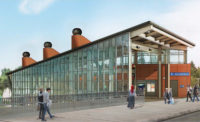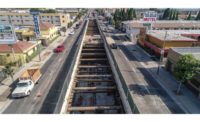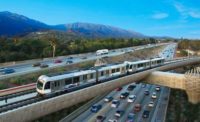The initial, starter light rail system in the Phoenix metropolitan area carries more than 14 million people each year along the 20-mile segment. Completed in late 2008, the line extends from a terminus in the southeast portion of the area in Mesa, then goes through Tempe on its way to the northwest terminus in Phoenix.
Ridership is expected to increase by about 10,000 riders per day later this year and into early 2016, when two new extensions that have been under construction since 2013 are brought online. The two projects will extend the line from the southeast terminus and the northwest terminus by approximately three miles.
The $200-million, design-build southeast extension—also known as the central Mesa extension—is being built by Valley Transit Constructors, a joint venture of Kiewit and Mass Electric. URS Corp. is providing consultancy work, and Jacobs Engineering is the engineer.
The $300-million, design-bid-build northwest extension is being constructed by a joint venture between Sundt and Stacy & Witbeck. Architecture services are being performed by Parsons Brinckerhoff and AECOM, with the latter also providing engineering services. More than 60 other subcontractors are also involved.
Managed by Valley Metro—the public entity that manages transit issues throughout the metropolitan area—the resulting light rail line is not just a transit option, but a member of the community.
According to those involved in the construction, the extensions required heavy amounts of road building, utility relocation and rail expertise in addition to responsiveness to the needs of business owners and residents who live and work along the construction zone.
The result was a complex project that was executed with the delicacy of a ballet.
"The easiest thing for us to do to get the job done safely and efficiently would be to shut a road down, but we had to balance those considerations against location," says Scott Miller, Sundt project manager.
The central Mesa extension required construction of a double track alignment within Main Street in Mesa from Sycamore Drive to Mesa Drive and included four stations, an on-street bus facility, paved track work, three traction power substation sites, signals, crossovers and communications.
Relocation of utilities serving surrounding businesses and residences was necessary for purposes of access once construction was complete. The utilities included fire hydrants in the median; electric, water and sewer lines; gas lines; storm drains; irrigation lines; and telephone and fiber optic lines.
Utility relocation began in spring 2012, with most of it completed early this year. "A majority of the first year's construction involved relocating utilities that could not land within 10 feet of the center line of the track perpendicular to the rail [while] all transverse 'wet' utilities needed to be 5 feet under the top of rail elevation," says Chris Chaffee, project manager, Valley Transit Constructors











Post a comment to this article
Report Abusive Comment